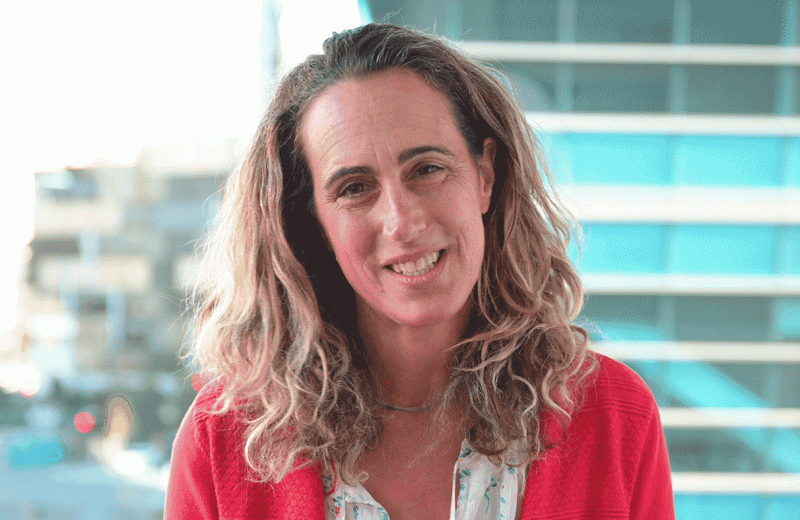Gladstone NOW: The Campaign Join Us on the Journey✕

SAN FRANCISCO, CA—Scientists at the Gladstone Institutes and the Stanford University School of Medicine have discovered how modifying a gene halts the toxic buildup of a protein found in nerve cells. These findings point to a potential new tactic for treating a variety of neurodegenerative conditions, including amyotrophic lateral sclerosis (ALS, or Lou Gehrig’s disease)—a fatal disease for which there is no cure.
The Gladstone and Stanford scientists began their experiments independently before realizing that combining their efforts could strengthen their results. Their discovery—which involved the work of both neuroscientists and geneticists—underscores the importance of collaborative and cross-disciplinary research when dealing with complex neurodegenerative diseases such as ALS.
ALS usually strikes between the ages of 40 and 75, ravaging the body’s motor neurons—nerve cells that control muscle movement. This causes muscle weakness, difficulty swallowing and breathing, paralysis and, ultimately, death—often just three to five years after diagnosis. At any given time, as many as 30,000 Americans are living with ALS—which afflicts physicist Stephen Hawking and which killed baseball legend Lou Gehrig.
In a paper published today online in Nature Genetics, researchers in the laboratories of Stanford Associate Professor Aaron D. Gitler, PhD, and Gladstone Senior Investigators Robert V. Farese, Jr., MD and Steve Finkbeiner, MD, PhD, describe how shutting off a gene called Dbr1 in yeast cells and in neurons obtained from rats can protect both cell types from the toxic effects of TDP-43—a protein that plays a key role in ALS.
“Mutations in the gene that produces TDP-43 can cause this protein to build up in cells,” said Dr. Farese, who is also a professor at the University of California, San Francisco, with which Gladstone is affiliated. “Over time, TDP-43 accumulation inside motor neurons can reach toxic levels and bind to RNAs—small bits of genetic material that act as an intermediary between genes and proteins. One theory is that this binding interferes with the RNAs’ normal functions and impairs the overall health of cells. Eventually, the neurons degrade and die, contributing to the rapid progression of ALS symptoms.”
It was already known that TDP-43 contributes to ALS. But disabling this protein directly is not an option, as TDP-43 is vital for cell survival. However, too much of it is toxic. So the Gladstone and Stanford researchers had to look for other genes that could be hijacked to reduce those toxic levels. One such gene, Dbr1, makes an enzyme that normally breaks down RNAs. The research teams found that if they lowered Dbr1 levels, the RNAs could not be broken down. These unprocessed RNAs could then serve as “bait” to bind to TDP-43, storing it away safely—and presumably allowing the RNAs that maintain healthy neurons to continue to function normally.
In laboratory experiments, Dr. Farese and Gladstone Postdoctoral Fellow Matthew Higgins, PhD, first showed that yeast makes an excellent model for studying ALS. Many RNA-processing genes in yeast resemble those found in humans—including Dbr1. At the same time, Dr. Gitler’s lab found that Dbr1 suppressed TDP-43 toxicity in yeast models. So, the Farese and Gitler laboratories compared these findings to those from rat neurons analyzed Dr. Finkbeiner’s lab.
“Even though millions of years of evolution separate yeast and rats, we found the same results in both models,” said Dr. Higgins, one of the study’s lead authors. “Our combined analyses revealed that the leftover RNAs acted as a decoy—tricking TDP-43 into binding them rather than the RNAs that are crucial for cell survival. The cells remained healthy.”
The findings—while preliminary—could have far-reaching implications, as they may be relevant also to other conditions besides ALS. For example, TDP-43 toxicity has also been observed in frontotemporal dementia (FTD), a form of early-onset dementia that causes progressive memory loss. However, questions remain before Dbr1 can be harnessed to treat patients.
“We don’t yet know how switching off the Dbr1 gene in a living organism will affect the organism’s overall health,” said Dr. Gitler, who is one of the paper’s senior authors. “Our next steps are to extend these studies from yeast and cell culture into live animal models. Then we can begin to identify small molecules that may inhibit Dbr1.”
“We are optimistic about what the results of our joint efforts might mean to ALS patients in the future,” added Dr. Finkbeiner, who is also a UCSF professor. “People with ALS have lived and died for far too long with no hope of recovery. We believe that these findings could be a step towards changing that.”
Gladstone Staff Scientist Sami Barmada, MD, PhD, and Gladstone Associate Investigator Nevan Krogan, PhD, also participated in this research. Funding sources include the Consortium for Frontotemporal Dementia Research, the ALS Association, the National Institute of Neurological Disorders and Stroke, the National Center for Research Resources and the National Institutes of Health.
Science in Seconds | The Thinking Microscope: Research Powered by an AI Brain
Science in Seconds | The Thinking Microscope: Research Powered by an AI Brain
In this video, Steve Finkbeiner and Jeremy Linsley showcase Gladstone’s groundbreaking “thinking microscope”—an AI-powered system that can design, conduct, and analyze experiments autonomously to uncover new insights into diseases like Alzheimer’s, Parkinson’s, and ALS.
Gladstone Experts ALS Alzheimer’s Disease Parkinson’s Disease Neurological Disease Finkbeiner Lab AI Big DataMeet Gladstone: Julia Kaye
Meet Gladstone: Julia Kaye
Julia Kaye is a neuroscientist at Gladstone Institutes dedicated to unraveling the mysteries of neurodegenerative diseases. Outside the lab, Kaye enjoys skateboarding, surfing, and exploring nature with her family.
Profile ALS Huntington’s Disease Multiple Sclerosis Neurological Disease KayeWorld’s Largest Public ALS Data Portal Launched
World’s Largest Public ALS Data Portal Launched
Steve Finkbeiner is leading key components of this unprecedented resource to boost ALS research.
Gladstone Experts ALS Center for Systems and Therapeutics Finkbeiner Lab AI Robotic Microscopy Stem Cells/iPSCs



